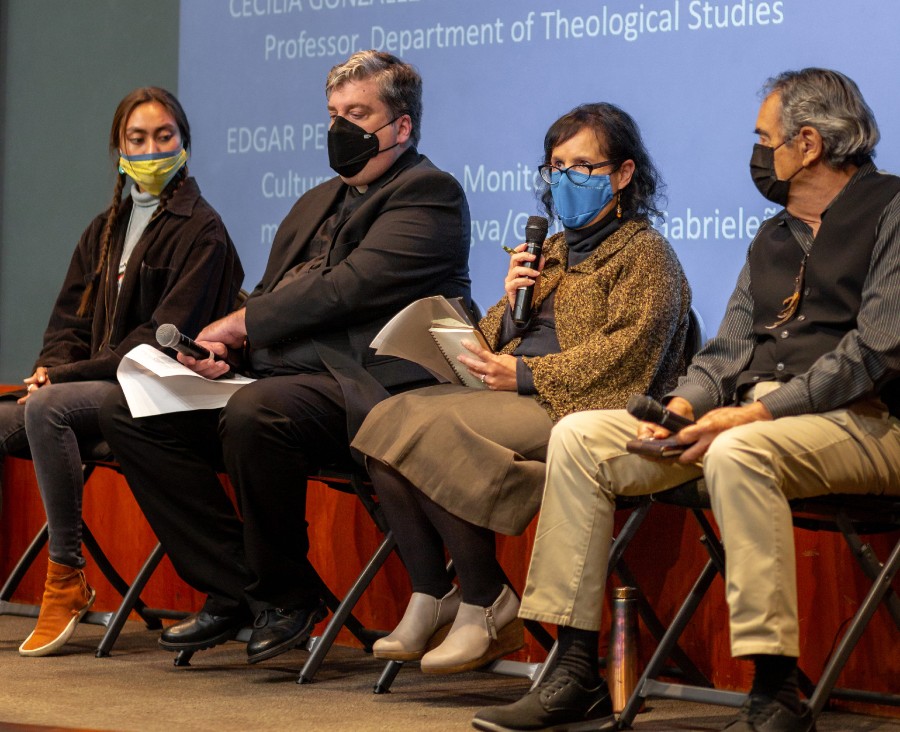
LMU ANTI-RACISM PROJECT | Reflecting the complex, fraught, and inextricable histories of Indigenous peoples, the state of California, Loyola Marymount University, and Father Junípero Serra, a noted historian and a select panel illuminated the issues involved in understanding and portraying that narrative on LMU’s campus.
The community discussion on Thursday, Nov. 4, 2021, in Ahmanson Auditorium, the first in LMU’s inaugural observance of Indigenous Heritage Month, was also prompted by the long-simmering controversy about Serra and the racial reckoning taking place across the United States. It also began a monthlong discernment leading to a Dec. 8 recommendation regarding LMU’s statue of the 18th century Franciscan missionary.
The featured speaker, Robert M. Senkewicz, emeritus history professor at Santa Clara University and author of “Junípero Serra: California, Indians, and the Transformation of a Missionary,” read two 1775 letters in Serra’s hand that illuminated the priest’s convoluted legacy: one letter to a viceroy sought forgiveness for Indigenous people who had rebelled against a mission; the second instructed harsh punishment for Indigenous people who had left the mission and were forcibly returned.
“Serra seems to be a person going back and forth when looking at his own ministry,” Senkewicz said.
The forum, attended by about 70 people and available online, opened with an acknowledgment regarding the “traditional, ancestral, and unceded” land of the Tongvaar peoples of the L.A. basin, including the bluff on which Loyola Marymount University is situated. Father Michael Engh, university chancellor, offered a revisioning of the Prayer of St. Francis, that said we welcome hard truths and seek justice. LMU student Than Povi Martinez, one of the panelists, offered a land blessing as a member of the Tewa people in New Mexico, translating her blessing into English.
The focus of this attention is LMU’s statue of Serra, which was dedicated outside of the then-Von der Ahe Library in the early 1990s, a gift of William H. Hannon. On the day of the dedication, a group of Native Americans protested by the flagpoles on Alumni Mall. While their voices were heard, critical dialogue and diverse perspectives about Serra’s historical role would not be explored until decades later. In the early summer of 2020, the statue was removed to conduct repairs and to consider potential relocation plans in response to community conversations and recommendations from the university’s Committee on Public Art and Images.
Representations and statues of Serra across the state have become objects of contention, often resulting in destruction. In 2018, Stanford University removed Serra’s name from various campus buildings. Also, officials in Ventura announced that they would remove the statue that stands in front of Ventura City Hall and place it in “a more appropriate non-public location,” and protesters in San Francisco toppled a statue of Serra in Golden Gate Park. In June 2020, the Serra statue that stood in Father Serra Park in Los Angeles was torn from its pedestal.
On the LMU campus, the L.A. Loyolan reported on Nov. 5, 2020, that LMU’s Indigenous Student Union (ISU) formally demanded that the statue of Serra stay off of campus permanently. In a statement made on Instagram, ISU said that the indefinite removal of the Serra statue would be “just one step” in recognizing that LMU resides on stolen Tongva land and creating a safe place for Indigenous students.
Senkewicz’s analysis focused on the mutually fortifying roles that the military and missionaries played in California. While the mission was evangelical, intending to convert Indigenous peoples to Catholicism, force of a martial nature was the accepted method. The growth of the California mission system and its core as the beginning of modern California, relied on this symbiosis. Later, after the missions were secularized, the representation of history and the missions written by Mexican and California officials erased the Native tribes and all they had suffered.
Moderated by Rubén Martinez, professor of English and Fletcher Jones Chair in Literature and Writing, the four-person panel approached the questions from their unique perspectives.
Than Povi Martinez, a sophomore dance major and woman of the Tewa Pueblo People of San Ildefonso, New Mexico, said that the statue of Serra represents pain and racism, and that it needs to go permanently. In her passionate talk she noted the trauma triggered by such representations and that Native peoples never had a chance to fully mourn the people who died in the missions.
Sean Dempsey, S.J., associate professor of history, noted that promoting the missions and the development of California is a 20th century idea that was related to promoting tourism in the West – it became a narrative that highlighted the good and obscured the painful past. Recent histories have documented the harder truths, but they compete with the mythology.
Describing herself as a public theologian, Cecilia González-Andrieu, professor of theological studies, asked why does this statue issue matter to us, and answered that these moments of discernment are God giving insights. For an artwork to be beautiful, she said, it must point us to what is true and truthful, and towards what is good, which is ultimately an orientation of love towards all. She noted that most of the missions are today parishes that serve neighborhoods that are primarily Latino, and often farmworkers, but that there is no devotion to Serra in these communities, an absence worth noting. The Catholic faith took root through the missions and the community’s wisdom must guide us, she said.
Edgar Perez, a member of the Tongva/Gabrielino/Gabrieleño community and a cultural resources monitor, said that the mission system held the seeds of the policies that separated Indigenous peoples from their language, their religion, and the distribution of lands. Native peoples’ dialects were taken away; Indigenous people were labeled pagans who “needed to see the light of the Gospel”; and when the land was redistributed, it went to wealthy families, not to Indigenous peoples as was promised. He said that Serra is an integral part of history and we should find a path to share that history and include Serra. Perez also called for universities such as LMU to offer Native American Studies courses to teach this complicated history and offer Native perspectives.
John Sebastian, vice president for Mission and Ministry, closed the evening by saying that the next steps involve convening a special subcommittee of the Public Arts and Images Committee and gathering community feedback before a Dec. 8 deadline to offer a recommendation for the disposition of the Serra statue. The group seeks input from the LMU community, and select external stakeholders, as part of their process.
Information about additional events and commemorations of Indigenous Heritage Month can be found at lmu.edu/indigenous.
DEI Buzz
- IHM hub and events
- Faculty and Staff Climate Surveys open until Dec 3.
-
- Faculty Survey
- Staff Survey
Spanish version of the staff survey will be available soon.
La semana que viene, estará disponible una versión en español de la encuesta sobre el clima y la cultura organizacional de la universidad . Gracias por su paciencia.
- Tomorrow, CTE workshop, 11/10 featuring Sheri Atwater (SoE), Vandana Thadani (PSYC), and Linda Kamiski (Grad) on “Colorblind Ideology is Not Equity.” Please find the zoom link here.
- “Who was Junípero Serra?” event video and feedback link (what is your opinion for displaying the Serra statue at LMU?)
- Last week to apply: DEI Grants Call for Proposals (due 11/15)
- Systemic Analysis Year 2 initiatives are in place.
-
- Register for a Report Out Session, where units who are in-progress will share their work and receive feedback from the community. Next report out is on Nov 16, 4-5pm featuring LMU Loyola Law School (and their new Anti-Racism Clinic) and LMU Athletics.
- Check out DEI’s Fall 2021 calendar.



